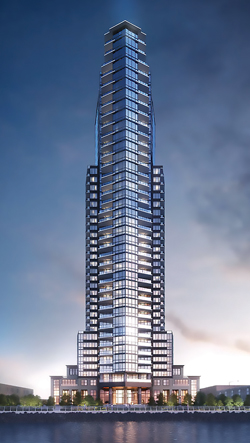Trending
A skyline worth staring at
Melding modernism and classicism at Mack’s Greenpoint tower

As the development and gentrification of Greenpoint and Williamsburg continue apace, a new building promises to contribute in a major way to the area’s stock of residential architecture. Designed by Ismael Leyva Architects, the Greenpoint, at 21 India Street, is a 400-foot-tall, 40-story rental and condo tower scheduled for completion in spring 2018. Part of a wave of development washing over the neighborhood — over 3,000 new apartments are expected to come on the market in the next three years, not including several thousand more that will be part of the 22-acre waterfront development Greenpoint Landing — the Greenpoint may well be the most striking building of the bunch.
The building was developed by Mack Real Estate Group together with Palin Enterprises and Urban Development Partners. Its lower 27 floors will contain 287 rentals, with 95 condo units above, ranging from studios to three-bedroom apartments. It is currently rising on the waterfront between India and Huron streets, next to the East River ferry stop. Right now, the area is a slightly forbidding zone of empty warehouses, most awaiting redevelopment. You will find few stores, dry cleaners, blades of grass or inhabitants — at least not human ones. The building the Greenpoint replaced was a nondescript, windowless and thoroughly uninviting one-story affair enlivened only by graffiti, metal fences and barbed wire. Facing Manhattan’s skyline, so close and yet so far, the faded letters of its façade declared to the inhabitants of that wealthier borough: “Huxley Envelope, Buy American.”
It may seem ironic that one of the main selling points of its replacement are those enviable views of Manhattan. But the famed Manhattan skyline, an object of longing and aspiration to previous generations of Brooklynites, means something very different to today’s denizens. To them, Manhattan is a kind of scenic wallpaper. Greenpoint’s waterfront, as yet undeveloped, presumes to confront Manhattan as an equal. But if the inhabitants of the Greenpoint have much to admire across the East River, their own building will return the favor, giving Manhattanites something to see that, in the fullness of time, combined with other developments, may come to rival Brooklyn Heights in its architectural and urban interest.
Leyva, the 64-year old Mexican-born architect, started his career working under Costas Kondylis, and he shares with the prolific New York architect a certain ad hoc development of formal ideas, an ability to turn on a dime from a modernist idiom to something like postmodern classicism. Among the projects he has worked on in New York are The Random House Tower, at 1745 Broadway, as well as the interiors of The Time Warner Building (both in collaboration with Skidmore Owings and Merrill). He has also designed the Charles Condominium, at 1355 First Avenue, and Place 57, at 207 East 57th Street.

Ismael Leyva
From a formal point of view, the Greenpoint embodies a paradox that is often evident in Leyva’s work. The language in which it has been conceived is that of mainstream modernism, but the massing and overall structure to which that language has been applied are strikingly traditional. In fact, it almost seems to recall something from the Art Deco era. To begin with, it has the grace not to meet the East River head-on but rather engages with it at a 45-degree angle. As a result of this ingenious variation, inhabitants are as likely to look out on Midtown and the Financial District as they are the somewhat less exciting towers of Stuyvesant Town, which stand directly opposite to it.
Like many more-traditional buildings in the city, such as the Chrysler and Empire State buildings, as well as Robert Stern’s 15 Central Park West, the Greenpoint is subject to a tripartite division into base, shaft and crown. Although the crown, in this case, is quite understated. The base, rising some four stories, is the most traditional part of the design, and in fact retains some fairly energetic elements of postmodernism that proclaim the gentrification that is promised by this entire development. The main entrance is adorned with rounded pillars and flanked by wings that terminate in diminutive pavilions. From the renderings, this entire part of the building appears to be clad in a gray granite, with mullioned windows and flat roofs crowned with discrete cornices.
The rest of the tower, however, is mainstream modern. The passage from the base to the shaft is mediated through two five-story structures that are the most pallidly modernist part of the Greenpoint and face the river frontally. The shaft of the building rises between them — a mix of glass-curtain walls and balconies on either side of the 45-degree angle. These balconies rise all the way to the 40th floor and are framed by what look to be thin rows of windows extending from about the 10th to the 30th floor. The building’s summit is a diminutive affair, but it gets the job done, capping the building instead of simply letting it run out of stories, as is the conventional modernist method.
It is, in the end, a conventional building. It does not try to be revolutionary — indeed, one suspects that such an ambition would run counter to the gentrified aspirations of its buyers. But, as a logical consequence of that conventionality, the building is eminently presentable, most likely pleasant to inhabit, and surely, from a purely visual perspective, far better than the one-story warehouse it replaces. If the rest of Greenpoint’s development is as satisfyingly competent as this, the boroughs of both Brooklyn and Manhattan will have much to be thankful for.




